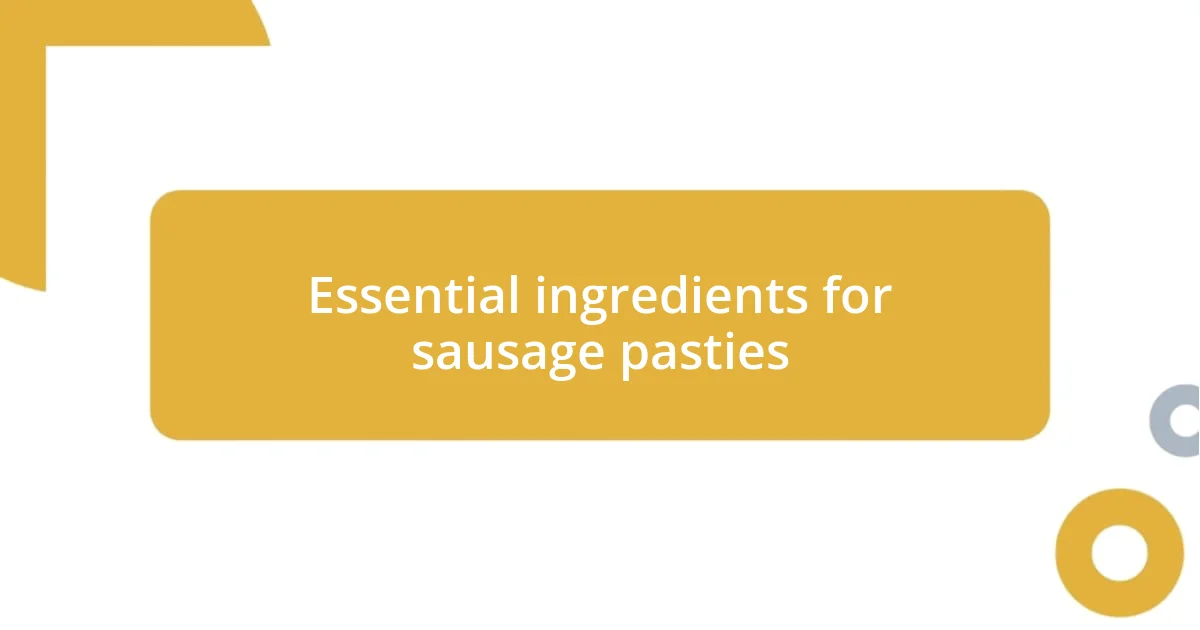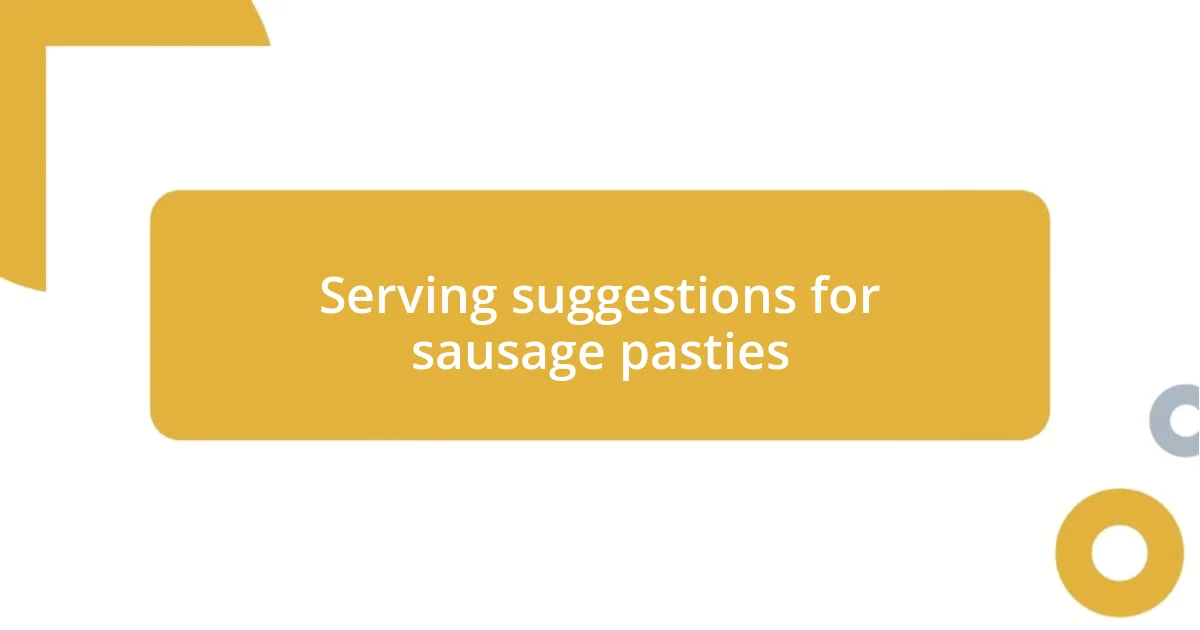Key takeaways:
- Mastering sausage pasties involves understanding the balance of quality ingredients, including well-seasoned sausage, onions, and the right type of pastry for texture.
- Technique is crucial: proper mixing, seasoning, and letting the filling rest enhance flavor and consistency.
- Serving suggestions can elevate the experience, with options like vibrant salads, rich gravies, and a variety of dipping sauces to impress guests.

Understanding sausage pasty basics
To truly appreciate the art of making sausage pasties, it’s essential to understand their core components: the pastry and the filling. I vividly remember the first time I attempted to make my own pastry; I was nervous, unsure if my dough would turn out flaky or flat. It’s that perfect balance of butter and flour that can make all the difference. Have you ever experienced the joy of pulling apart a warm, flaky pastry? There’s nothing quite like it.
Now, let’s talk about the filling. Traditional sausage pasties usually feature well-seasoned sausage, often mixed with ingredients like onions and potatoes. I once added a touch of herbs, thinking it would elevate the flavor, and it truly transformed the dish. Don’t be afraid to experiment—it’s all about finding that harmony of flavors that resonates with you. What are your favorite ingredients to mix in?
Finally, the construction of the pasty itself is an art form worthy of a workshop. Making sure the edges are crimped properly ensures a delightful seal, locking in all those mouthwatering flavors. I’ll never forget the first time I turned a seemingly chaotic mixture into a beautifully crafted pasty. What started as a mess turned into something satisfying and beautiful, a true testament to the joy of cooking. This process is not just about food; it’s about creating something meaningful that fills the belly and warms the heart.

Essential ingredients for sausage pasties
When it comes to crafting the perfect sausage pasty, the ingredients are not just functional—they’re integral to the experience. I recall meticulously choosing my sausage, hovering over the display at the butcher’s shop, absorbing all the enticing aromas. It’s important to select a high-quality sausage that has a good balance of meat and fat. This makes your filling juicy and flavorful, ensuring every bite is a taste sensation.
Here’s a quick breakdown of the essential ingredients you’ll need for your sausage pasties:
- Sausage: Choose fresh, good-quality sausage. Flavored varieties can add unique twists!
- Onion: Adds sweetness and depth; sauté them lightly for enhanced flavor.
- Potatoes: Diced or grated—these provide heartiness and absorb other flavors beautifully.
- Herbs and spices: Fresh parsley or thyme can elevate your filling beyond the ordinary.
- Pastry: A buttery shortcrust is traditional, but phyllo offers an interesting texture variation.
I remember the first time I added a few chopped apples to the mix, thinking it might be a gamble. It turned into a delightful surprise that added a pleasant sweetness, showcasing how even a small addition can make a significant difference. Cooking is all about exploration, so don’t shy away from personal touches!

Choosing the right pastry type
Choosing the right pastry for your sausage pasty is crucial. I distinctly remember my first trial with a puff pastry—while it certainly looked appealing, the texture ended up being too light and flaky for my hearty filling. Instead, I found that a shortcrust pastry gave me the sturdy foundation I needed, creating a delightful contrast to the juicy filling. This balance opened my eyes to the impact pastry choices can have on the final dish.
For those curious about the types available, I’ve played around with both shortcrust and puff pastry, and each has its unique qualities. Shortcrust is robust and crumbly, perfect for a filling that packs a punch. Meanwhile, puff pastry brings a buttery, flaky element—but sometimes that can overshadow the flavors of the filling. Reflecting on my experience, I learned to choose based on what I wanted the pasty to express. What texture are you aiming for?
To help you decide, I’ve compiled a quick comparison of different pastry types:
| Pastry Type | Texture |
|---|---|
| Shortcrust | Robust and crumbly |
| Puff | Light and flaky |
| Phyllo | Crispy and delicate |
Ultimately, choosing the right pastry type is about finding a match for your filling. I encourage you to experiment; I once tried using a phyllo pastry and was thrilled with the delightful crunch it added! How do you envision your ideal sausage pasty?

Step by step preparation guide
To get started on the preparation, I recommend preheating your oven to 200°C (about 400°F) to create an ideal baking environment. While that’s happening, chop your onions and potatoes, and get your sausage ready. In my early attempts, I would sometimes skip the sautéing step for the onions, thinking it wouldn’t matter. What a mistake! I discovered that gently cooking them first brings out their natural sweetness and really enhances the flavors of the filling.
Once your ingredients are prepped, it’s all about mixing everything together. I like to combine the sausage, sautéed onions, diced potatoes, and herbs in a large bowl, giving it a good mix with my hands. Getting my hands in there really helps me gauge the texture—it’s almost therapeutic! You want everything to be well incorporated, so take your time.
After mixing, roll out your pastry on a lightly floured surface. I didn’t realize at first how important it is to roll it out to an even thickness; uneven pastry can lead to parts that are undercooked. It’s all in the details! I typically cut out circles or squares, depending on the shape I’m going for. Don’t forget to leave enough space around the filling for sealing the edges! Do you remember the first time you struggled with sealing a pasty? My first few were a messy affair with stuffing spilling out, but with practice, it became second nature.

Perfecting the filling techniques
Perfecting your filling techniques is where the magic truly happens. I still fondly recall the moment I realized the importance of seasoning. In one early batch, I was cautious—afraid of overpowering the sausage—but it ended up rather bland. Now, I’ve learned that a good balance of spices, like paprika and a hint of thyme, not only elevates the flavor but also makes each bite an adventure. Have you ever tasted a dish and thought, “This could use a little something extra”? That’s the power of seasoning!
Another aspect I now prioritize is ensuring that my filling has a uniform consistency. The first few times I made pasties, I often ended up with a mixture that had chunky bits of sausage and mashed potatoes. It wasn’t pleasing to the eye or the palate. I found that using a food processor to blend the meat with the other ingredients results in a smoother, creamy texture that holds together beautifully. Have you experimented with blending techniques? If not, I highly recommend giving it a try!
Lastly, I’ve discovered the significance of allowing the filling to rest before encasing it in pastry. The first time I skipped this step, I was eager to get them in the oven, yet I ended up with soggy bottoms. Letting the filling cool for about 15 minutes helps it firm up, making it easier to handle. Plus, the flavors meld together beautifully during that time. Trust me, that extra patience pays off in the final product. What unique methods have you found helpful in your cooking journey?

Serving suggestions for sausage pasties
Sausage pasties are versatile, and how you serve them can elevate the experience! I often enjoy them straight out of the oven, golden brown and flaky. But if I’m feeling adventurous, pairing them with a vibrant salad adds a refreshing crunch. I remember one dinner where I served pasties alongside a zingy coleslaw; the contrasting textures and flavors were a big hit!
For a cozy night in, consider serving your pasties with a rich gravy or a flavorful chutney for dipping. In my experience, nothing beats a warm pasty dipped into a homemade apple chutney—it brings out the savory notes of the sausage beautifully. Have you ever tried this combination? The way the sweet and spicy chutney complements the dish is absolutely delightful!
If you’re hosting a gathering, presenting pasties on a large platter with an assortment of dipping sauces can really impress your guests. Think of a tangy mustard, a creamy horseradish, or even a garlic aioli for an extra kick. I once created a DIY pasty bar at a small party, and it turned into a fun conversation starter as everyone mixed and matched dips. It’s incredibly satisfying to see your loved ones experimenting and finding their own favorite pairings!















